Analysis of Southwest Airlines' Low-Cost Strategy and Company Culture
VerifiedAdded on 2021/06/15
|5
|932
|32
Case Study
AI Summary
This case study analysis examines Southwest Airlines' implementation of its low-cost, no-frills strategy, exploring its key policies, procedures, operating practices, and core values. It highlights the airline's efficient maintenance, point-to-point flight scheduling, and use of derivative contracts for fuel cost management. The analysis also delves into the key elements of Southwest's strong company culture, emphasizing employee welfare, fun work environment, and employee engagement strategies. Furthermore, it discusses the challenges Gary Kelly faces in sustaining the culture after Herb Kelleher's departure and emphasizes the importance of employee contribution towards profitability and cost reduction. The case study references relevant academic sources to support its findings.
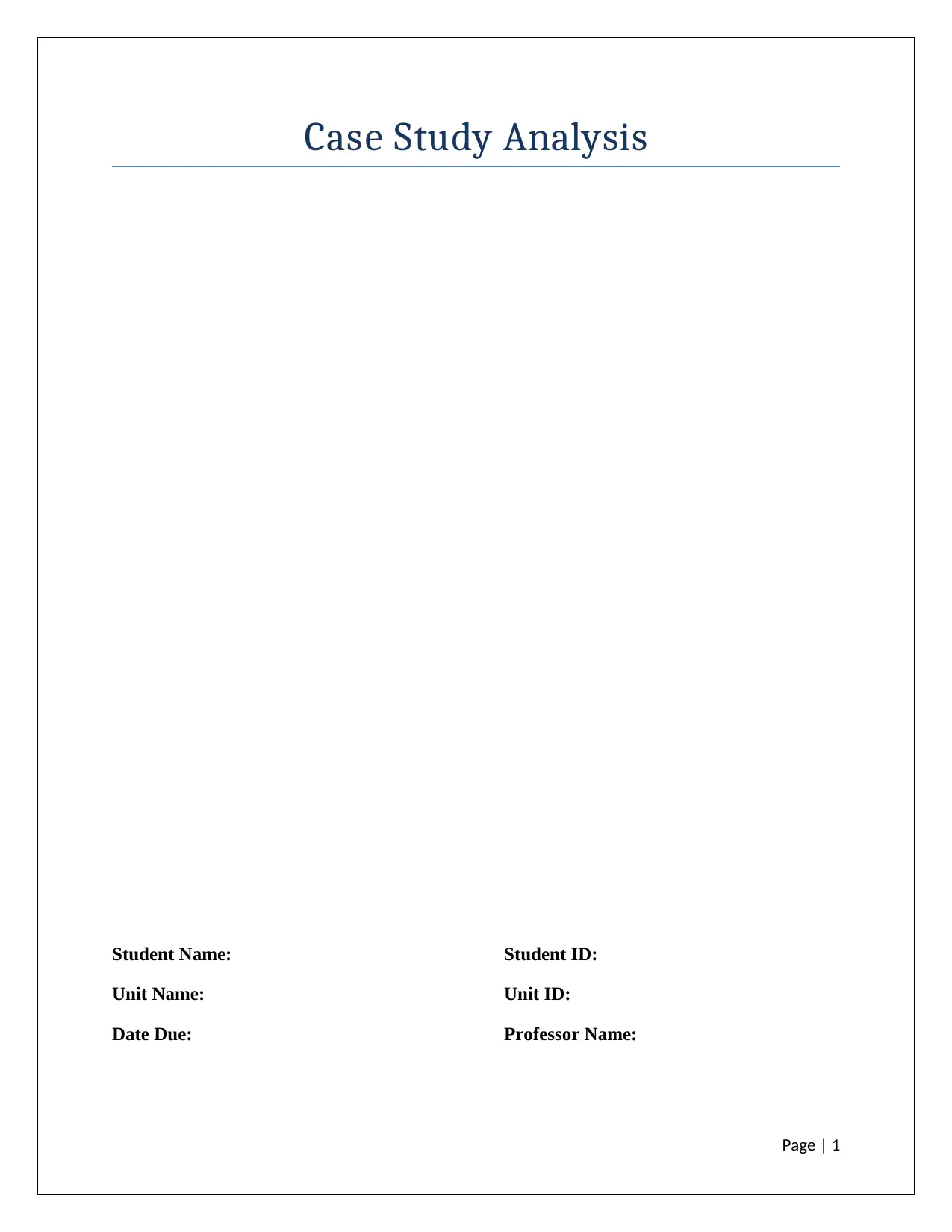
Case Study Analysis
Student Name: Student ID:
Unit Name: Unit ID:
Date Due: Professor Name:
Page | 1
Student Name: Student ID:
Unit Name: Unit ID:
Date Due: Professor Name:
Page | 1
Paraphrase This Document
Need a fresh take? Get an instant paraphrase of this document with our AI Paraphraser
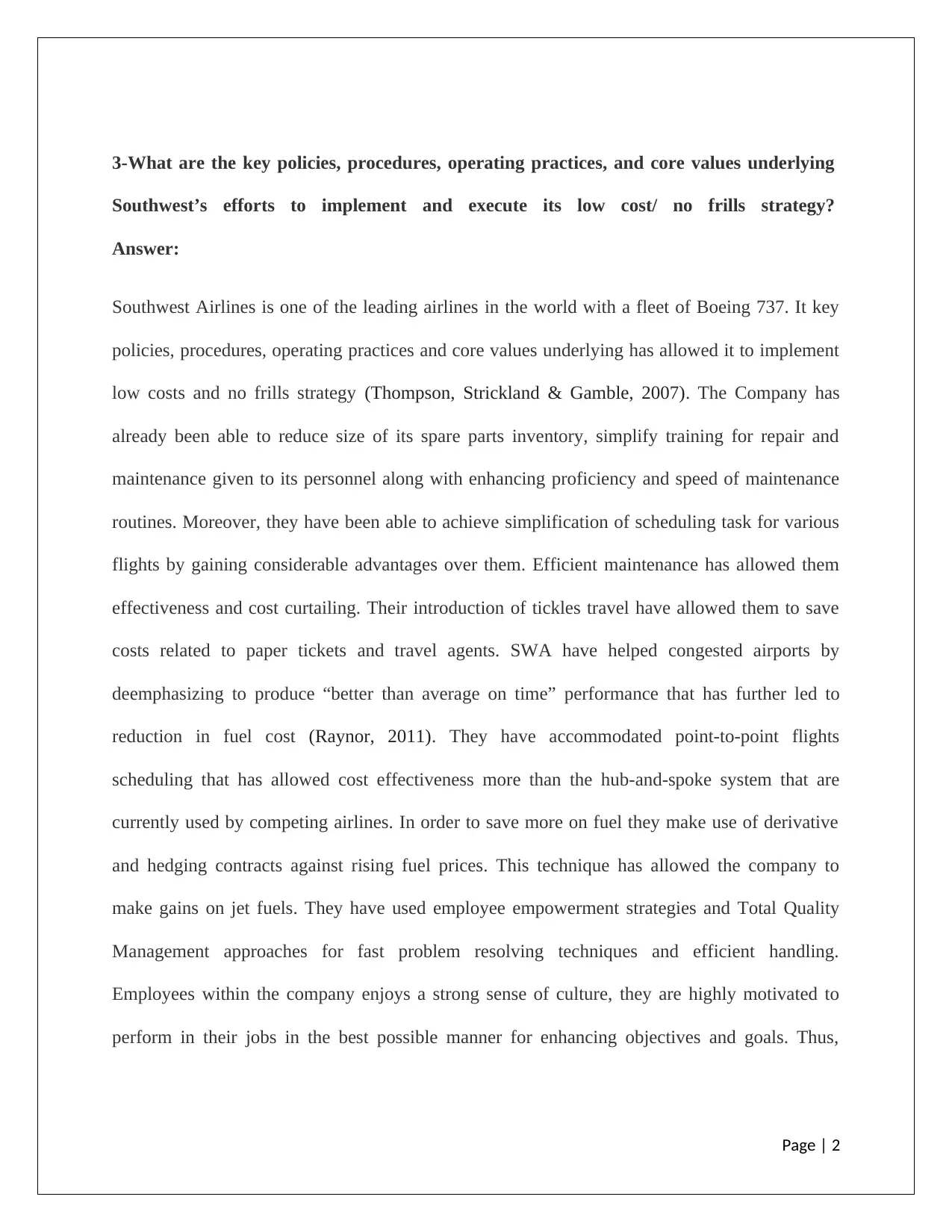
3-What are the key policies, procedures, operating practices, and core values underlying
Southwest’s efforts to implement and execute its low cost/ no frills strategy?
Answer:
Southwest Airlines is one of the leading airlines in the world with a fleet of Boeing 737. It key
policies, procedures, operating practices and core values underlying has allowed it to implement
low costs and no frills strategy (Thompson, Strickland & Gamble, 2007). The Company has
already been able to reduce size of its spare parts inventory, simplify training for repair and
maintenance given to its personnel along with enhancing proficiency and speed of maintenance
routines. Moreover, they have been able to achieve simplification of scheduling task for various
flights by gaining considerable advantages over them. Efficient maintenance has allowed them
effectiveness and cost curtailing. Their introduction of tickles travel have allowed them to save
costs related to paper tickets and travel agents. SWA have helped congested airports by
deemphasizing to produce “better than average on time” performance that has further led to
reduction in fuel cost (Raynor, 2011). They have accommodated point-to-point flights
scheduling that has allowed cost effectiveness more than the hub-and-spoke system that are
currently used by competing airlines. In order to save more on fuel they make use of derivative
and hedging contracts against rising fuel prices. This technique has allowed the company to
make gains on jet fuels. They have used employee empowerment strategies and Total Quality
Management approaches for fast problem resolving techniques and efficient handling.
Employees within the company enjoys a strong sense of culture, they are highly motivated to
perform in their jobs in the best possible manner for enhancing objectives and goals. Thus,
Page | 2
Southwest’s efforts to implement and execute its low cost/ no frills strategy?
Answer:
Southwest Airlines is one of the leading airlines in the world with a fleet of Boeing 737. It key
policies, procedures, operating practices and core values underlying has allowed it to implement
low costs and no frills strategy (Thompson, Strickland & Gamble, 2007). The Company has
already been able to reduce size of its spare parts inventory, simplify training for repair and
maintenance given to its personnel along with enhancing proficiency and speed of maintenance
routines. Moreover, they have been able to achieve simplification of scheduling task for various
flights by gaining considerable advantages over them. Efficient maintenance has allowed them
effectiveness and cost curtailing. Their introduction of tickles travel have allowed them to save
costs related to paper tickets and travel agents. SWA have helped congested airports by
deemphasizing to produce “better than average on time” performance that has further led to
reduction in fuel cost (Raynor, 2011). They have accommodated point-to-point flights
scheduling that has allowed cost effectiveness more than the hub-and-spoke system that are
currently used by competing airlines. In order to save more on fuel they make use of derivative
and hedging contracts against rising fuel prices. This technique has allowed the company to
make gains on jet fuels. They have used employee empowerment strategies and Total Quality
Management approaches for fast problem resolving techniques and efficient handling.
Employees within the company enjoys a strong sense of culture, they are highly motivated to
perform in their jobs in the best possible manner for enhancing objectives and goals. Thus,
Page | 2
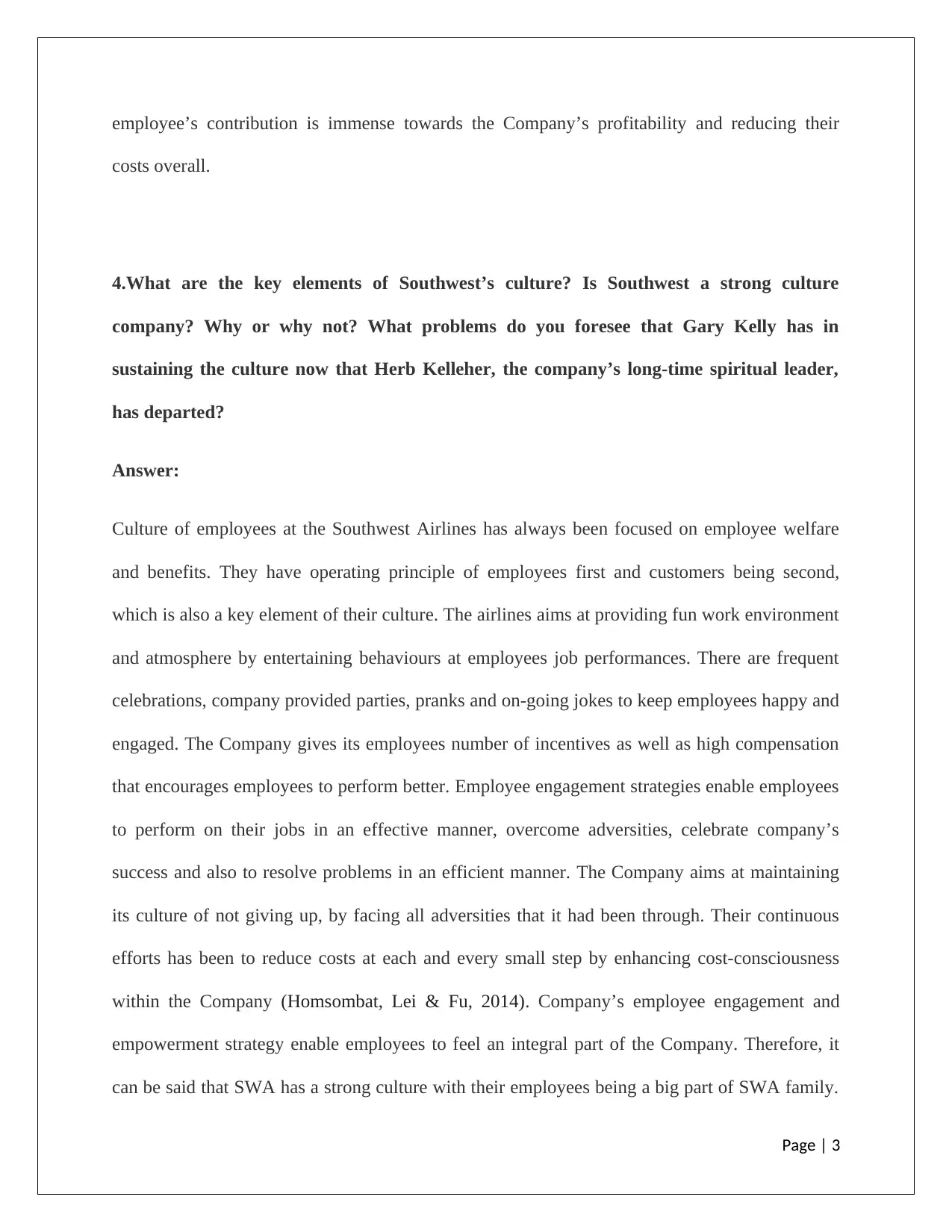
employee’s contribution is immense towards the Company’s profitability and reducing their
costs overall.
4.What are the key elements of Southwest’s culture? Is Southwest a strong culture
company? Why or why not? What problems do you foresee that Gary Kelly has in
sustaining the culture now that Herb Kelleher, the company’s long-time spiritual leader,
has departed?
Answer:
Culture of employees at the Southwest Airlines has always been focused on employee welfare
and benefits. They have operating principle of employees first and customers being second,
which is also a key element of their culture. The airlines aims at providing fun work environment
and atmosphere by entertaining behaviours at employees job performances. There are frequent
celebrations, company provided parties, pranks and on-going jokes to keep employees happy and
engaged. The Company gives its employees number of incentives as well as high compensation
that encourages employees to perform better. Employee engagement strategies enable employees
to perform on their jobs in an effective manner, overcome adversities, celebrate company’s
success and also to resolve problems in an efficient manner. The Company aims at maintaining
its culture of not giving up, by facing all adversities that it had been through. Their continuous
efforts has been to reduce costs at each and every small step by enhancing cost-consciousness
within the Company (Homsombat, Lei & Fu, 2014). Company’s employee engagement and
empowerment strategy enable employees to feel an integral part of the Company. Therefore, it
can be said that SWA has a strong culture with their employees being a big part of SWA family.
Page | 3
costs overall.
4.What are the key elements of Southwest’s culture? Is Southwest a strong culture
company? Why or why not? What problems do you foresee that Gary Kelly has in
sustaining the culture now that Herb Kelleher, the company’s long-time spiritual leader,
has departed?
Answer:
Culture of employees at the Southwest Airlines has always been focused on employee welfare
and benefits. They have operating principle of employees first and customers being second,
which is also a key element of their culture. The airlines aims at providing fun work environment
and atmosphere by entertaining behaviours at employees job performances. There are frequent
celebrations, company provided parties, pranks and on-going jokes to keep employees happy and
engaged. The Company gives its employees number of incentives as well as high compensation
that encourages employees to perform better. Employee engagement strategies enable employees
to perform on their jobs in an effective manner, overcome adversities, celebrate company’s
success and also to resolve problems in an efficient manner. The Company aims at maintaining
its culture of not giving up, by facing all adversities that it had been through. Their continuous
efforts has been to reduce costs at each and every small step by enhancing cost-consciousness
within the Company (Homsombat, Lei & Fu, 2014). Company’s employee engagement and
empowerment strategy enable employees to feel an integral part of the Company. Therefore, it
can be said that SWA has a strong culture with their employees being a big part of SWA family.
Page | 3
⊘ This is a preview!⊘
Do you want full access?
Subscribe today to unlock all pages.

Trusted by 1+ million students worldwide
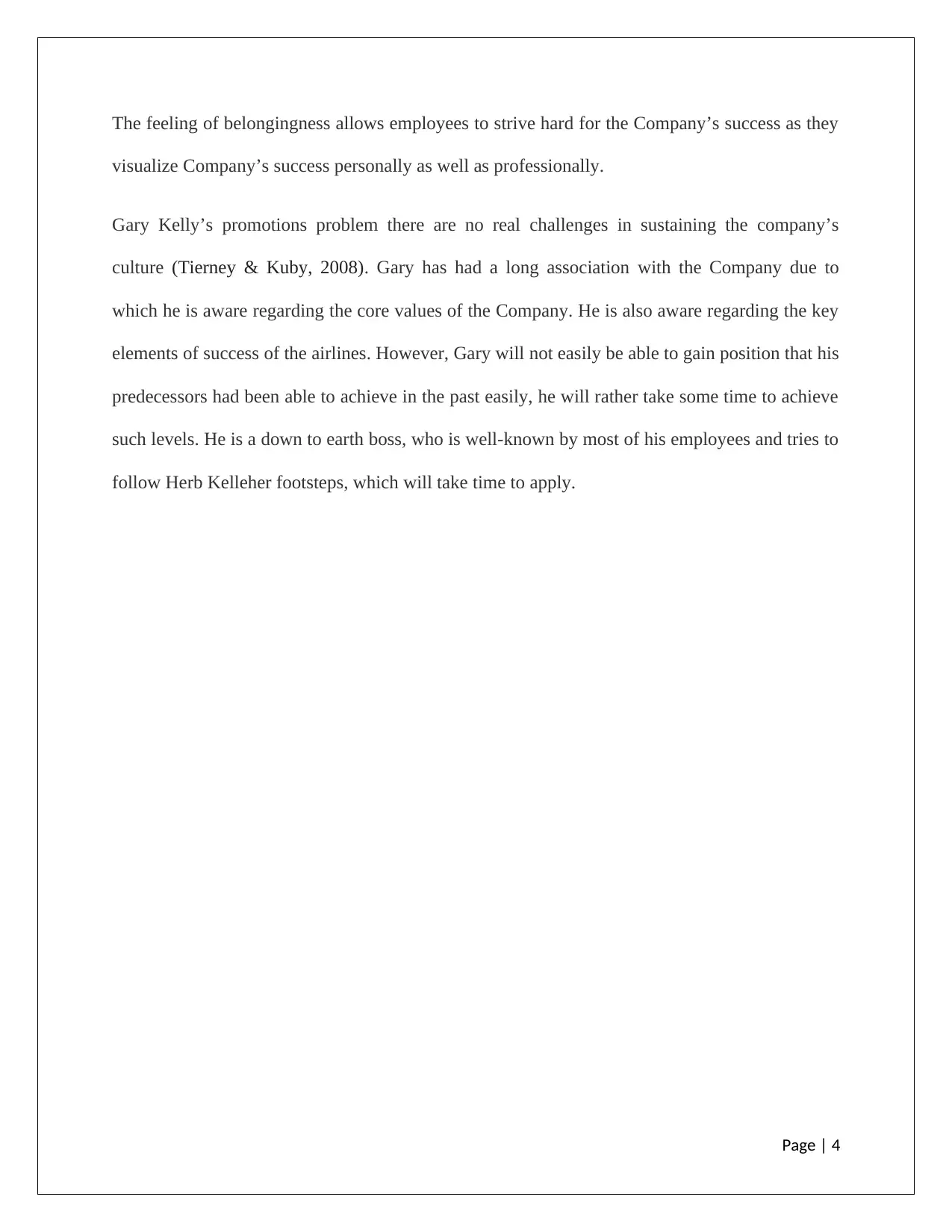
The feeling of belongingness allows employees to strive hard for the Company’s success as they
visualize Company’s success personally as well as professionally.
Gary Kelly’s promotions problem there are no real challenges in sustaining the company’s
culture (Tierney & Kuby, 2008). Gary has had a long association with the Company due to
which he is aware regarding the core values of the Company. He is also aware regarding the key
elements of success of the airlines. However, Gary will not easily be able to gain position that his
predecessors had been able to achieve in the past easily, he will rather take some time to achieve
such levels. He is a down to earth boss, who is well-known by most of his employees and tries to
follow Herb Kelleher footsteps, which will take time to apply.
Page | 4
visualize Company’s success personally as well as professionally.
Gary Kelly’s promotions problem there are no real challenges in sustaining the company’s
culture (Tierney & Kuby, 2008). Gary has had a long association with the Company due to
which he is aware regarding the core values of the Company. He is also aware regarding the key
elements of success of the airlines. However, Gary will not easily be able to gain position that his
predecessors had been able to achieve in the past easily, he will rather take some time to achieve
such levels. He is a down to earth boss, who is well-known by most of his employees and tries to
follow Herb Kelleher footsteps, which will take time to apply.
Page | 4
Paraphrase This Document
Need a fresh take? Get an instant paraphrase of this document with our AI Paraphraser
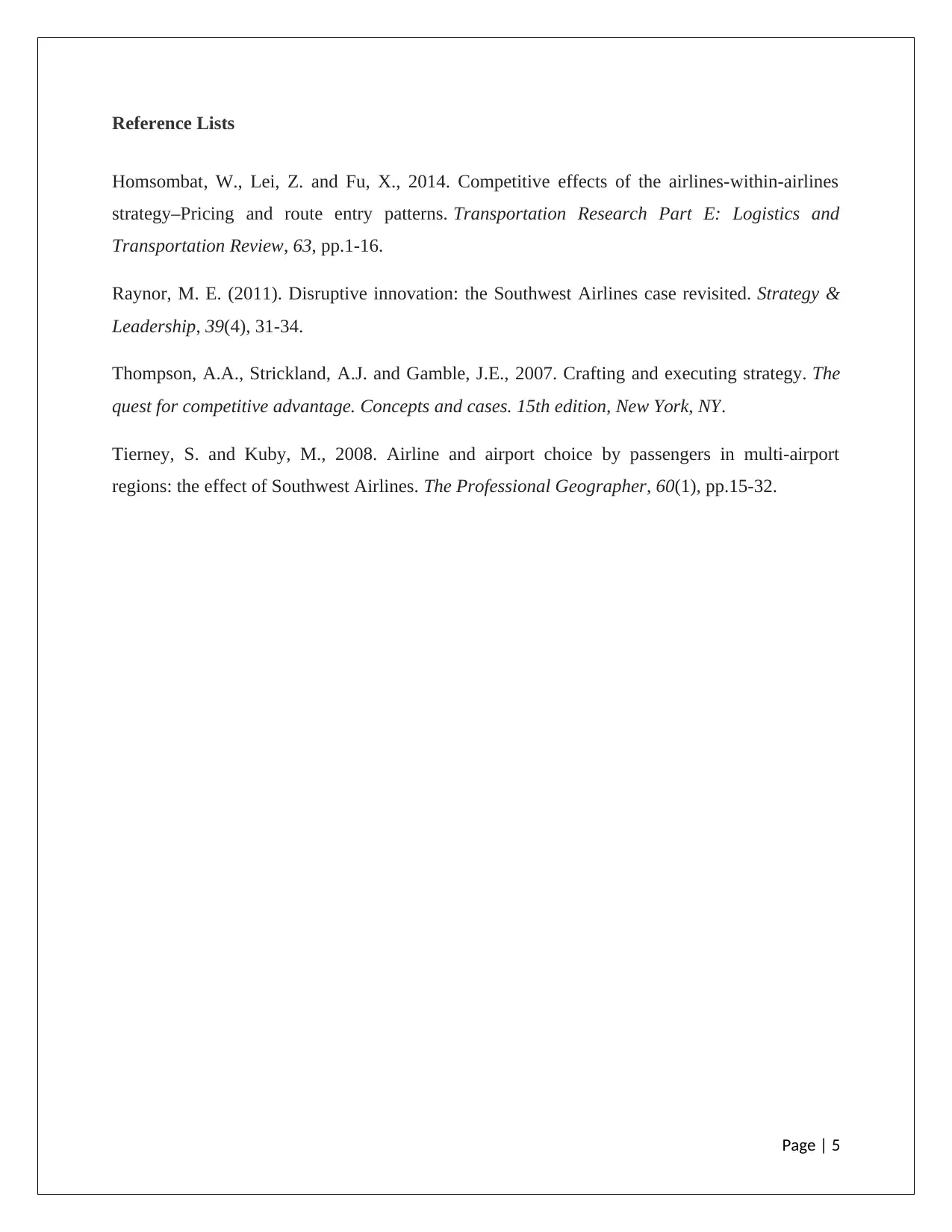
Reference Lists
Homsombat, W., Lei, Z. and Fu, X., 2014. Competitive effects of the airlines-within-airlines
strategy–Pricing and route entry patterns. Transportation Research Part E: Logistics and
Transportation Review, 63, pp.1-16.
Raynor, M. E. (2011). Disruptive innovation: the Southwest Airlines case revisited. Strategy &
Leadership, 39(4), 31-34.
Thompson, A.A., Strickland, A.J. and Gamble, J.E., 2007. Crafting and executing strategy. The
quest for competitive advantage. Concepts and cases. 15th edition, New York, NY.
Tierney, S. and Kuby, M., 2008. Airline and airport choice by passengers in multi-airport
regions: the effect of Southwest Airlines. The Professional Geographer, 60(1), pp.15-32.
Page | 5
Homsombat, W., Lei, Z. and Fu, X., 2014. Competitive effects of the airlines-within-airlines
strategy–Pricing and route entry patterns. Transportation Research Part E: Logistics and
Transportation Review, 63, pp.1-16.
Raynor, M. E. (2011). Disruptive innovation: the Southwest Airlines case revisited. Strategy &
Leadership, 39(4), 31-34.
Thompson, A.A., Strickland, A.J. and Gamble, J.E., 2007. Crafting and executing strategy. The
quest for competitive advantage. Concepts and cases. 15th edition, New York, NY.
Tierney, S. and Kuby, M., 2008. Airline and airport choice by passengers in multi-airport
regions: the effect of Southwest Airlines. The Professional Geographer, 60(1), pp.15-32.
Page | 5
1 out of 5
Related Documents
Your All-in-One AI-Powered Toolkit for Academic Success.
+13062052269
info@desklib.com
Available 24*7 on WhatsApp / Email
![[object Object]](/_next/static/media/star-bottom.7253800d.svg)
Unlock your academic potential
Copyright © 2020–2025 A2Z Services. All Rights Reserved. Developed and managed by ZUCOL.





